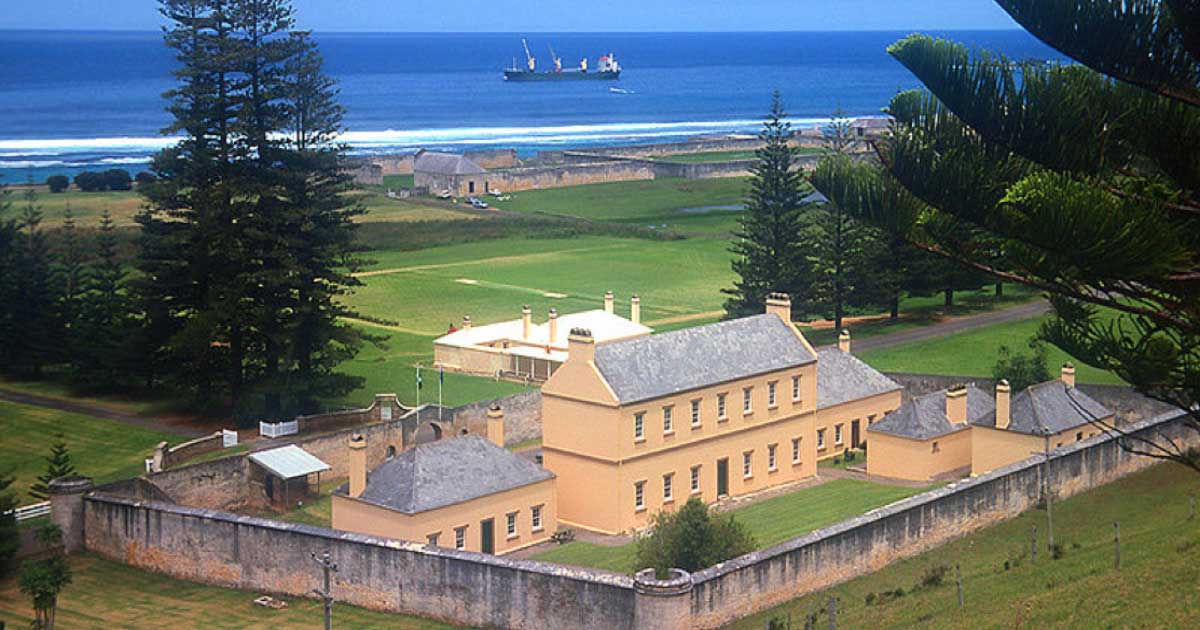Kingston and Arthurs Vale Historic Area on Norfolk Island was Hell in Paradise
Australia is famous for its convict settlements and penal colonies. One of the most important and infamous convict settlements was at Norfolk Island in the South Pacific Sea. Today the penal colony can be visited in the Kingston and Arthurs Vale Historic Area (KAVHA) which is of huge historical significance to Australia and has been recognized by UNESCO as a world heritage site.
The History of Norfolk Island
The first settlement on the site was by Polynesians who may have come from New Zealand in the 13 th or 14 th century, but they later abandoned the islands. Norfolk Island is one of the few areas in Australian territory where there is evidence of Polynesian settlement. Their ultimate fate is a mystery as the only remains of their presence has been established in one area of the island. After Captain Cook re-discovered the islands in the eighteenth century, the British colonial government decided to use Norfolk as a penal colony.

Remains of a prison at KAVHA on Norfolk Island (1825-55). (Denisbin / CC BY 2.0)
Little Hope of Escape from This Remote and Harsh Penal Colony
KAVHA is located on the southern side of Norfolk Island, not far from the capital of Kingston, and is surrounded by densely forested hills. Norfolk Island lies 990 miles or 1550 kilometers off the east coast of Australia, located between Australia, New Zealand and New Caledonia. It was inhabited by some free settlers and convicts who provided the island’s workforce in the 1780s. Although the settlers were expected to provide the Royal Navy in the South Pacific with supplies, the colony failed to develop and was abandoned in 1814. In the 1820s the British government designated the island as a penal colony where repeat offenders were sent from Australia. The island’s remoteness meant that it was ideal for those judged to be incorrigible offenders such as convicts who escaped their prisons and became bushrangers. Norfolk soon earned a reputation as one of the toughest penal settlements in the colonies and it was commonly known as ‘hell in paradise’. However, there were also efforts to reform the prisoners.

Prison structures for convicts on Norfolk Island (Denisbin / CC BY 2.0)
In the colony the convicts worked on a farm and labored on various building projects. There were several revolts by the prisoners in an effort to escape from the island which the authorities suppressed with executions and savage punishments. The prison settlement was closed in the 1850s after the Westminster Parliament prohibited transportation as a punishment. The Colonial authorities decided that the island was of strategic importance and encouraged people from the Pitcairn Islands to settle on Norfolk. Many of these were the descendants of sailors who had taken part in the mutiny on the Bounty. Today, the island is part of Australia and has limited self-government.
KAVHA Offers Unparalleled Insight into the History of Norfolk Island and Australia
The Australian government recognized the importance of the penal settlement and set up the KAVHA, to preserve the location for posterity. It was recognized as one of the best surviving examples of the large-scale convict settlements and is one of the official sites listed in the Australian Convict Sites World Heritage series.
- 2,500-year-old convicts’ cemetery discovered in Greece
- Spiky Bridge: Tasmania’s Quirky Wall with Convict Heritage
- These walls can talk: Australian history preserved by folk magic

Many of the graves are those of the convicts (Randal /Fotolia)
The site is approximately 250 acres in extent with archaeological remains from the two periods when the island was a penal colony. Among the buildings that have been restored are Government House and the barracks that once housed the soldiers who guarded the prisoners. There are also some fine examples of Victorian houses where officers and their families lived. In addition, there are ruins of jails and places of punishment, remains of mills, workshops, and other structures. The area also has some of the first dwellings of the Pitcairn Islanders who were brought to the island after the closure of the penal colony. The ruins and standing structures of the original prison which can still be seen which help visitors appreciate the reality of life on a penal settlement.

Quality Row - officers lived in private houses and the soldiers lived in barracks. (Denisbin/ CC BY 2.0)
The area also has some archaeological remains of the first Polynesian inhabitants of the island, such as the remains of a rudimentary ceremonial structure ( marae) which was very important in Polynesian religion and politics. The entire area offers an unprecedented insight into the history of not only Norfolk Island, but also of Australia. It is located in an extraordinary and magical landscape. As well as a research and information office on the site, there are also four museums, each dedicated to some aspect of the history of KAVHA.
Experience KAVHA for Yourself
The area is near the International Airport and is located adjacent to a wildlife and nature reserve. An admission fee is required to enter the heritage park which enables a visitor to enter the four museums. Guided tours are available and it is also possible to tour KAVHA by car.
Top image: Prison turned government building at KAVHA on Norfolk Island (1825-55). Source: CC BY 3.0
By Ed Whelan
References
Best, M. 2007. Norfolk Island: Thanatourism, history and visitor emotions. Shima: The International Journal of Research into Island Cultures, 1(2), pp.30-48
Available at: http://shimajournal.org/issues/v1n2/e.-Best-Shima-v1n2.pdf
Morris, N. 2003. Maconochie's gentlemen: The story of Norfolk Island and the roots of modern prison reform. Oxford University Press
Mühlhäusler, P. and Nash, J. 2012. Norfolk Island: history, people, environment, language. Battlebridge Publications
Available at: https://hekyll.services.adelaide.edu.au/dspace/handle/2440/74392




















Comments
Nice work, Ed Whelan